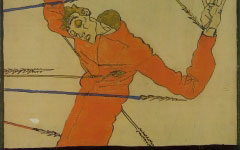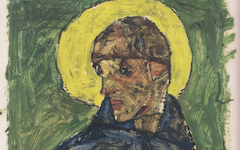Schiele’s Bare Tree Behind a Fence (1912)
Egon Schiele's Bare Tree Behind a Fence (left) was painted one year before his Self-portrait as a Saint which we have already shown contains a large S for Schiele. Here - who needs to be shown? - there is a large E for Egon.
Click next thumbnail to continue
If you look closer, though, you will see that each of the horizontal strokes of the E branch out into smaller E's, a tree-diagram perhaps of how every painter paints himself, his mind as the large E conceiving further images of his mind conceiving as one grows into the other. Though leafless in winter, the tree is rooted in the wisdom of the ages and its struggle to survive is a metaphor for the violence and mental struggle of creation.
Is it a stretch, though, to read the image as inside his mind? I don't think so.
Click next thumbnail to continue

L: Schiele, Bare Tree Behind a Fence (1912)
R: Diagram of Schiele's Self-portrait with Arm Twisting Above Head (1910)
Click image to enlarge.
Not only does the concept conform to so many of the world's masterpieces, as shown on EPPH, but the earth transforms Schiele's own forehead and hair. A tree grows out of his "head". The area below the horizon is an extreme metamorphic close-up of his famous hairline. I have blurred the lower part of a 1910 self-portrait (right) to highlight this similarity.
See conclusion below
Schiele's method could have been inspired by the work of many different artists but this example is strikingly similar to some of Rembrandt's landscapes with their extreme close-up views of his own head. For comparison, take a look at Rembrandt's Landscape with a Stone Bridge (1638) and his etching of The Three Trees (1643).
More Works by Schiele
The concise expression of meaning is as aesthetically satisfying in art as it is in poetry

Schiele’s Embrace (1912)
Notes:
Original Publication Date on EPPH: 15 Mar 2015. © Simon Abrahams. Articles on this site are the copyright of Simon Abrahams. To use copyrighted material in print or other media for purposes beyond 'fair use', you must obtain permission from the copyright owner. Websites may link to this page without permission (please do) but may not reproduce the material on their own site without crediting Simon Abrahams and EPPH.




